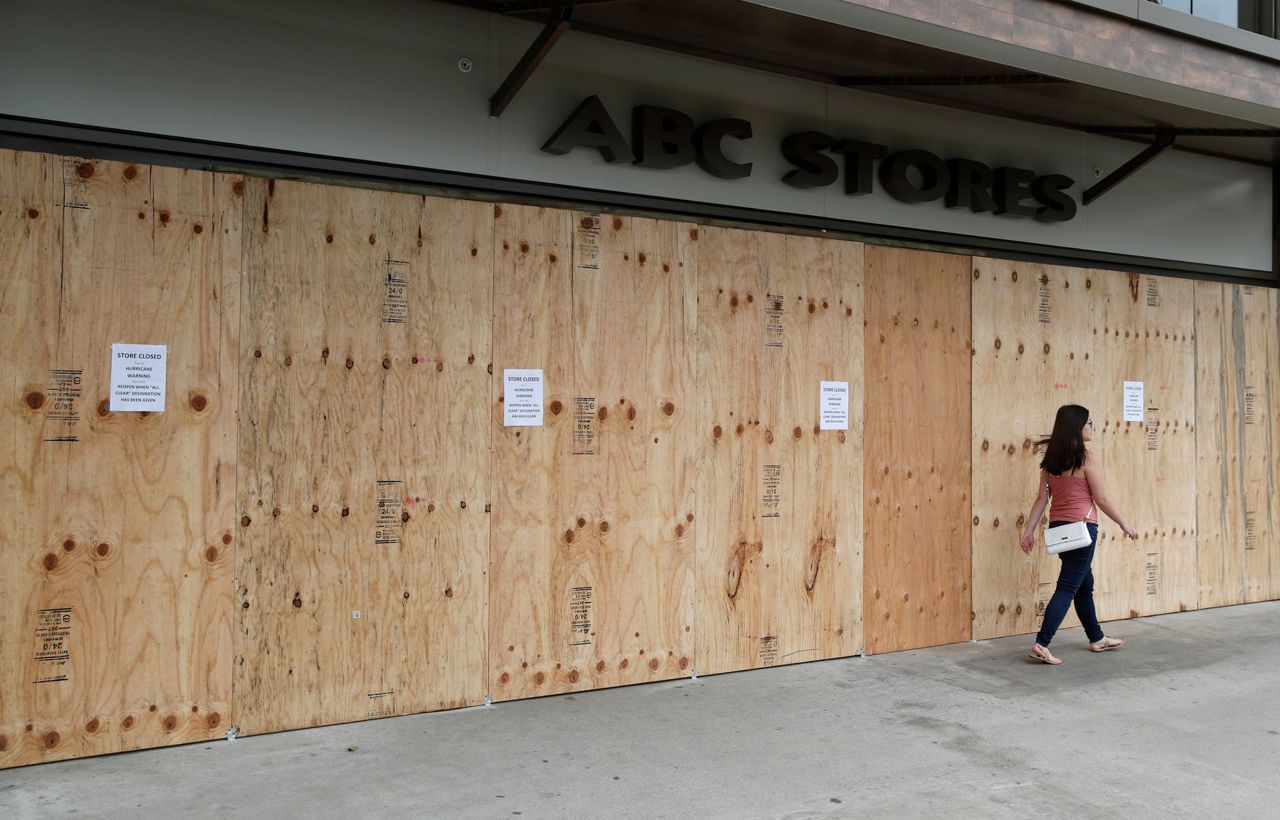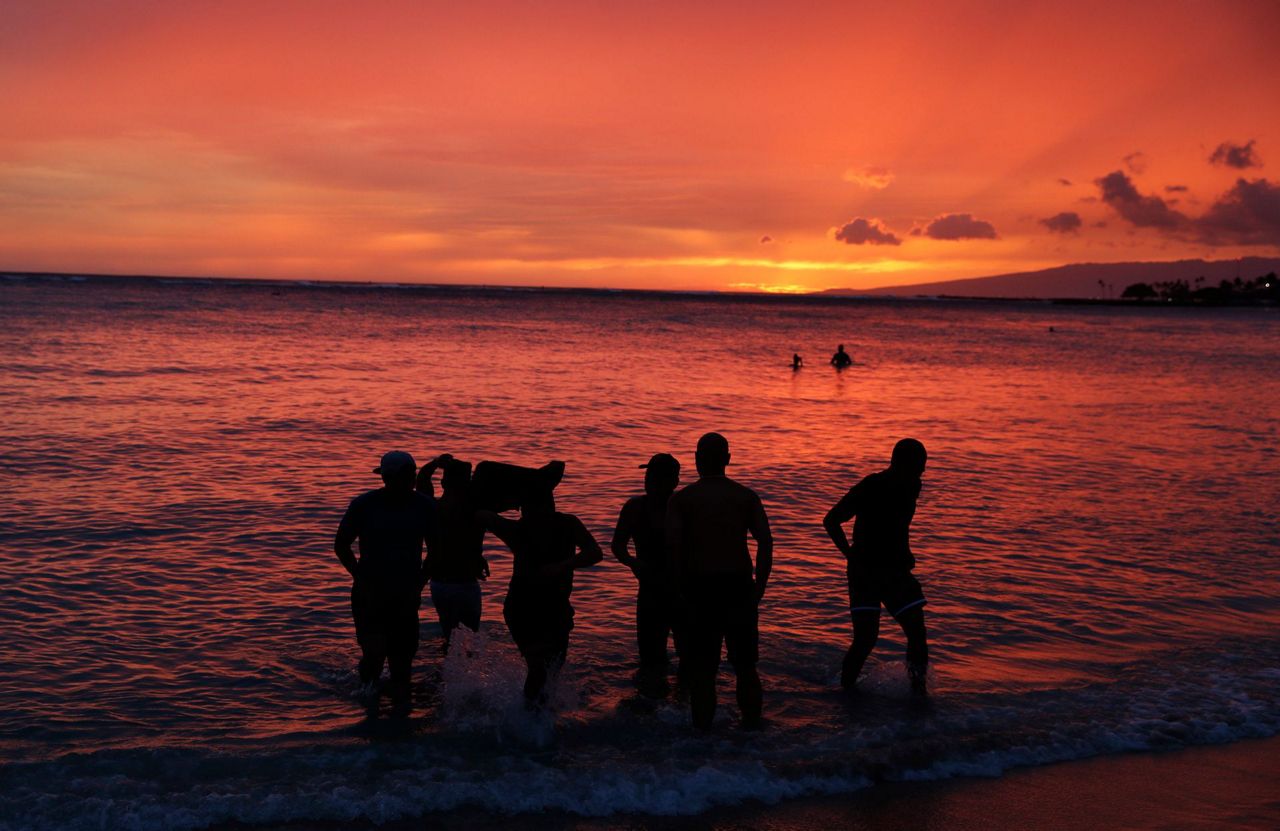HONOLULU (AP) — Hurricane Lane weakened to a tropical storm on Friday as it headed toward the Hawaiian islands. But it still brought torrential rains that immersed a city in waist-deep water and forced people to flee flooding homes, while others jumped off seawalls with boogie boards into the turbulent ocean.
As many dealt with flooding and even brush fires, swimmers and surfers ignored warnings from authorities and plunged into powerful waves at Oahu's famed Waikiki Beach, which was closed.
Emergency officials said repeatedly over loudspeakers: "Please get out of the water! It's very dangerous!" Honolulu's mayor pleaded with tourists that they were putting themselves in danger as the storm churned closer.
The National Weather Service downgraded the storm to a tropical storm with winds of up to 70 mph (110 kmph) as it headed north toward the islands. It was expected to veer west, skirting the islands, but still threatened to bring heavy rains and strong, gusty winds statewide, meteorologist Gavin Shigesato said.
A hurricane watch for Oahu and Maui was downgraded to a tropical storm watch. Still, meteorologists warned that Lane could trigger flash flooding and inflict wind damage.
The outer bands of the hurricane dumped as much as 3 feet (1 meter) of rain in 48 hours on the mostly rural Big Island. The main town of Hilo, population 43,000, was flooded Friday with waist-high water as landslides shut down roads.
Margaret Collins, 69, woke up Thursday night to the sound of moving water in her Hilo backyard.
"So I got up out of bed and looked out my bedroom window and saw water 3 feet high gushing past my window," she said. "And that's when I realized I was standing in water."
She called a neighbor for help, who crawled through bushes to bring her out of the house, half-carrying her as she clutched a plastic bag with medication.
The gushing water knocked down a cement wall and lifted her truck out of the carport, sending it toward her neighbor's house, she said.
"My house is completely inundated with mudwater," said Collins, who was told the damage wouldn't be covered by insurance. She hopes she can get federal assistance.
Elsewhere on the Big Island, the National Guard and firefighters rescued six people and a dog from a flooded home, while five California tourists were rescued from another house.
A different type of evacuation took place on Oahu — the state's most populated island.
Officials with the Department of Land and Natural Resources transferred about 2,000 rare Hawaiian snails from a mountain marsh to offices in downtown Honolulu. A staffer will spend the night and place ice around their cages in case the air conditioning goes out.
Some of the snails are the last of their kind, including one named George that's the sole remaining Achatinella apexfulva in captivity. Staff members are trying to keep him safe in case he's able to reproduce.
As flooding hit the Big Island, brush fires broke out in areas of Maui and Oahu susceptible to flames.
Some residents in a shelter on Maui had to flee when a fire got too close and another forced people from their homes. A woman got burns on her hands and legs and was flown to Honolulu, Maui County spokesman Rod Antone said. Her condition wasn't clear.
A man posted a video on Instagram showing flames several stories high starting to envelop parked cars. Josh Galinato said he was trying to sleep when he smelled smoke in his apartment in the tourist town of Lahaina.
"I opened up my front door, and I just saw the fire spreading and coming downhill," Galinato said. He and neighbors honked horns to alert others to the danger.
Joseph Azam, who was vacationing in Maui with family and friends, hoped rain from the hurricane arrived before the flames did.
"Trying to figure which comes first, the fire or the rain," said Azam, who's from Oakland, California, and is staying at a hotel. "We're praying the rain arrives soon."
Others prayed it to stay away.
In Waikiki, the man-made Ala Wai Canal is likely to flood if predicted rains arrive, said Ray Alexander of the U.S. Army Corps of Engineers. The canal marks the northern boundary of the Waikiki tourist district. Worries that it could overflow in heavy rains have prompted plans to mitigate the risk.
"The canal has flooded in the past, and I believe it's safe to say based on the forecast of rainfall it's likely to flood again — the impacts of which we aren't prepared to say at this time," Alexander said.
Major flooding could damage 3,000 structures and cost more than $1 billion in repairs, the Honolulu Star-Advertiser newspaper reported, citing corps estimates.
Officials received $345 million last summer to build detention basins, a flood wall and pumping station, beginning in 2020 and expected to be completed in 2023, Alexander said.
Employees have filled sandbags to protect oceanfront hotels from surging surf. Stores along Waikiki's glitzy Kalakaua Avenue stacked sandbags along the bottom of their glass windows to prepare for flash flooding, while residents lined up at stores to stockpile supplies.
Away from the high-rise hotels of Waikiki, Crystal Bowden, a tourist from California, watched powerful waves crash against cliffs on Oahu's southeast coast.
"I came in to visit, got here just in time for the hurricane," Bowden said. "We're kind of excited."
Almost 16,000 homes and businesses on the islands lost power, but service was restored to some, Hawaiian Electric spokesman Peter Rosegg said.
Federal Emergency Management Agency officials said about 2,000 people were in shelters, mostly in Oahu.
The central Pacific gets fewer hurricanes than other regions, with about only four or five named storms a year. Hawaii rarely gets hit. The last major storm to hit was Iniki in 1992. Others have come close in recent years.
___
Associated Press writers Brian Skoloff and Caleb Jones in Honolulu, Mark Thiessen and Dan Joling in Anchorage, Alaska, Colleen Long in Washington and Alina Hartounian and Annika Wolters in Phoenix contributed to this report.
Copyright 2018 The Associated Press. All rights reserved. This material may not be published, broadcast, rewritten or redistributed.


















